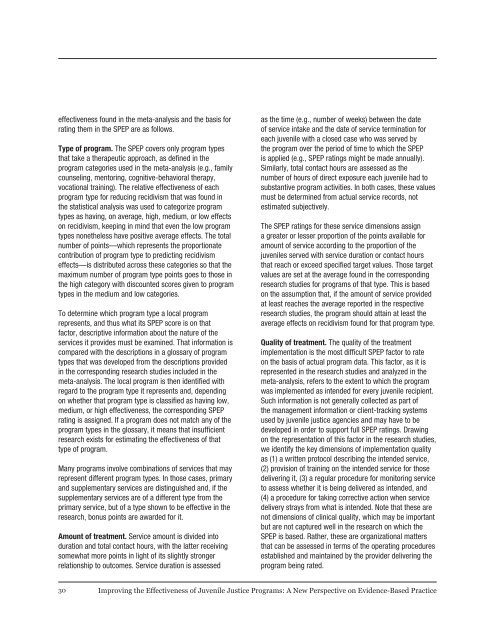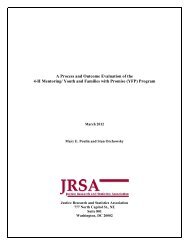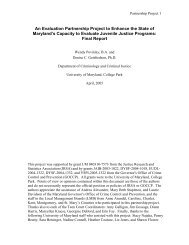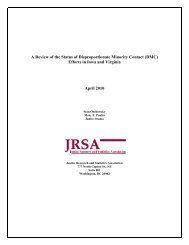Improving the Effectiveness of Juvenile Justice Programs: A New
Improving the Effectiveness of Juvenile Justice Programs: A New
Improving the Effectiveness of Juvenile Justice Programs: A New
Create successful ePaper yourself
Turn your PDF publications into a flip-book with our unique Google optimized e-Paper software.
effectiveness found in <strong>the</strong> meta-analysis and <strong>the</strong> basis for<br />
rating <strong>the</strong>m in <strong>the</strong> SPEP are as follows.<br />
Type <strong>of</strong> program. The SPEP covers only program types<br />
that take a <strong>the</strong>rapeutic approach, as defined in <strong>the</strong><br />
program categories used in <strong>the</strong> meta-analysis (e.g., family<br />
counseling, mentoring, cognitive-behavioral <strong>the</strong>rapy,<br />
vocational training). The relative effectiveness <strong>of</strong> each<br />
program type for reducing recidivism that was found in<br />
<strong>the</strong> statistical analysis was used to categorize program<br />
types as having, on average, high, medium, or low effects<br />
on recidivism, keeping in mind that even <strong>the</strong> low program<br />
types none<strong>the</strong>less have positive average effects. The total<br />
number <strong>of</strong> points—which represents <strong>the</strong> proportionate<br />
contribution <strong>of</strong> program type to predicting recidivism<br />
effects—is distributed across <strong>the</strong>se categories so that <strong>the</strong><br />
maximum number <strong>of</strong> program type points goes to those in<br />
<strong>the</strong> high category with discounted scores given to program<br />
types in <strong>the</strong> medium and low categories.<br />
To determine which program type a local program<br />
represents, and thus what its SPEP score is on that<br />
factor, descriptive information about <strong>the</strong> nature <strong>of</strong> <strong>the</strong><br />
services it provides must be examined. That information is<br />
compared with <strong>the</strong> descriptions in a glossary <strong>of</strong> program<br />
types that was developed from <strong>the</strong> descriptions provided<br />
in <strong>the</strong> corresponding research studies included in <strong>the</strong><br />
meta-analysis. The local program is <strong>the</strong>n identified with<br />
regard to <strong>the</strong> program type it represents and, depending<br />
on whe<strong>the</strong>r that program type is classified as having low,<br />
medium, or high effectiveness, <strong>the</strong> corresponding SPEP<br />
rating is assigned. If a program does not match any <strong>of</strong> <strong>the</strong><br />
program types in <strong>the</strong> glossary, it means that insufficient<br />
research exists for estimating <strong>the</strong> effectiveness <strong>of</strong> that<br />
type <strong>of</strong> program.<br />
Many programs involve combinations <strong>of</strong> services that may<br />
represent different program types. In those cases, primary<br />
and supplementary services are distinguished and, if <strong>the</strong><br />
supplementary services are <strong>of</strong> a different type from <strong>the</strong><br />
primary service, but <strong>of</strong> a type shown to be effective in <strong>the</strong><br />
research, bonus points are awarded for it.<br />
Amount <strong>of</strong> treatment. Service amount is divided into<br />
duration and total contact hours, with <strong>the</strong> latter receiving<br />
somewhat more points in light <strong>of</strong> its slightly stronger<br />
relationship to outcomes. Service duration is assessed<br />
as <strong>the</strong> time (e.g., number <strong>of</strong> weeks) between <strong>the</strong> date<br />
<strong>of</strong> service intake and <strong>the</strong> date <strong>of</strong> service termination for<br />
each juvenile with a closed case who was served by<br />
<strong>the</strong> program over <strong>the</strong> period <strong>of</strong> time to which <strong>the</strong> SPEP<br />
is applied (e.g., SPEP ratings might be made annually).<br />
Similarly, total contact hours are assessed as <strong>the</strong><br />
number <strong>of</strong> hours <strong>of</strong> direct exposure each juvenile had to<br />
substantive program activities. In both cases, <strong>the</strong>se values<br />
must be determined from actual service records, not<br />
estimated subjectively.<br />
The SPEP ratings for <strong>the</strong>se service dimensions assign<br />
a greater or lesser proportion <strong>of</strong> <strong>the</strong> points available for<br />
amount <strong>of</strong> service according to <strong>the</strong> proportion <strong>of</strong> <strong>the</strong><br />
juveniles served with service duration or contact hours<br />
that reach or exceed specified target values. Those target<br />
values are set at <strong>the</strong> average found in <strong>the</strong> corresponding<br />
research studies for programs <strong>of</strong> that type. This is based<br />
on <strong>the</strong> assumption that, if <strong>the</strong> amount <strong>of</strong> service provided<br />
at least reaches <strong>the</strong> average reported in <strong>the</strong> respective<br />
research studies, <strong>the</strong> program should attain at least <strong>the</strong><br />
average effects on recidivism found for that program type.<br />
Quality <strong>of</strong> treatment. The quality <strong>of</strong> <strong>the</strong> treatment<br />
implementation is <strong>the</strong> most difficult SPEP factor to rate<br />
on <strong>the</strong> basis <strong>of</strong> actual program data. This factor, as it is<br />
represented in <strong>the</strong> research studies and analyzed in <strong>the</strong><br />
meta-analysis, refers to <strong>the</strong> extent to which <strong>the</strong> program<br />
was implemented as intended for every juvenile recipient.<br />
Such information is not generally collected as part <strong>of</strong><br />
<strong>the</strong> management information or client-tracking systems<br />
used by juvenile justice agencies and may have to be<br />
developed in order to support full SPEP ratings. Drawing<br />
on <strong>the</strong> representation <strong>of</strong> this factor in <strong>the</strong> research studies,<br />
we identify <strong>the</strong> key dimensions <strong>of</strong> implementation quality<br />
as (1) a written protocol describing <strong>the</strong> intended service,<br />
(2) provision <strong>of</strong> training on <strong>the</strong> intended service for those<br />
delivering it, (3) a regular procedure for monitoring service<br />
to assess whe<strong>the</strong>r it is being delivered as intended, and<br />
(4) a procedure for taking corrective action when service<br />
delivery strays from what is intended. Note that <strong>the</strong>se are<br />
not dimensions <strong>of</strong> clinical quality, which may be important<br />
but are not captured well in <strong>the</strong> research on which <strong>the</strong><br />
SPEP is based. Ra<strong>the</strong>r, <strong>the</strong>se are organizational matters<br />
that can be assessed in terms <strong>of</strong> <strong>the</strong> operating procedures<br />
established and maintained by <strong>the</strong> provider delivering <strong>the</strong><br />
program being rated.<br />
30 <strong>Improving</strong> <strong>the</strong> <strong>Effectiveness</strong> <strong>of</strong> <strong>Juvenile</strong> <strong>Justice</strong> <strong>Programs</strong>: A <strong>New</strong> Perspective on Evidence-Based Practice

















